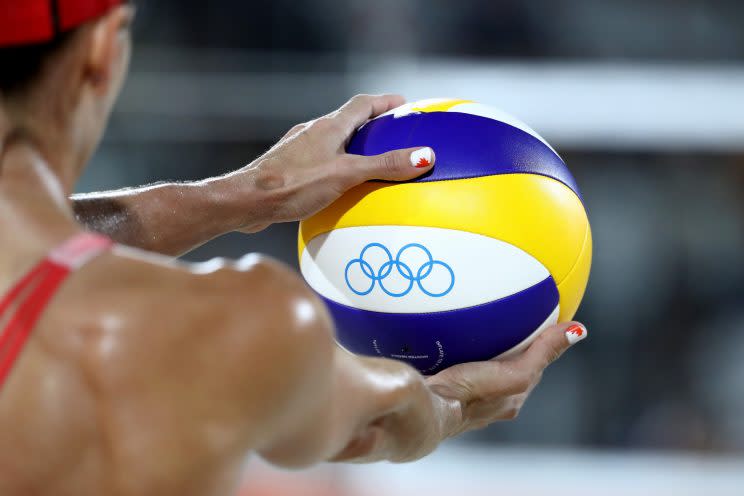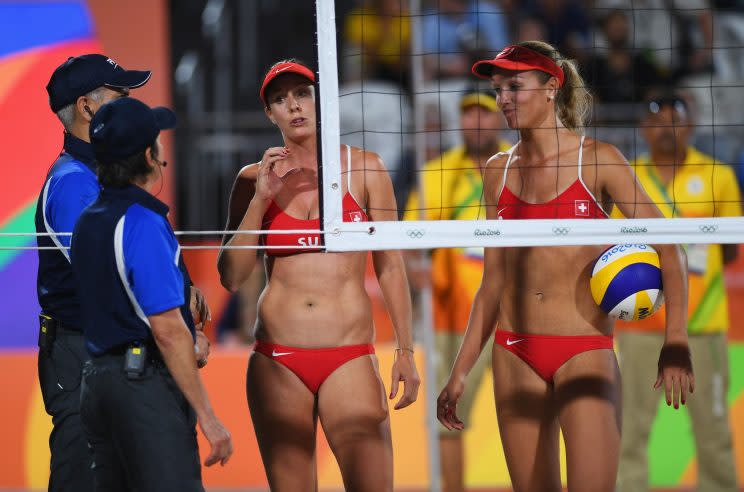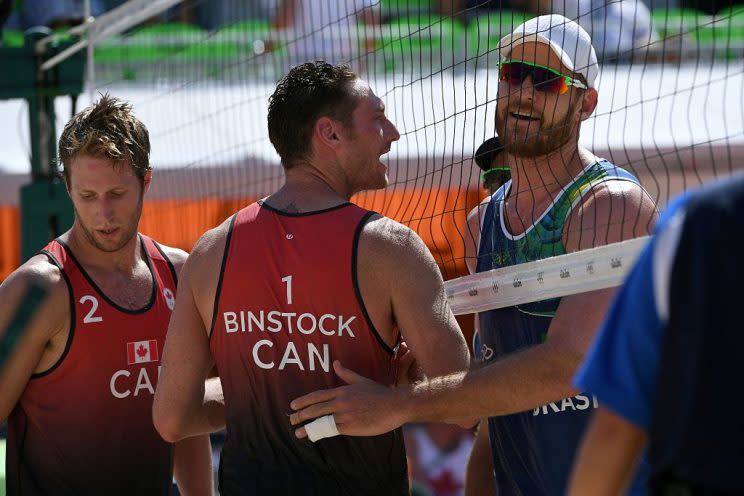Controversial beach volleyball challenge system under fire in Rio

RIO DE JANEIRO – Beach volleyball has the most raucous party atmosphere at the Rio Olympics. But the sport’s controversial new video review challenge system has become the proverbial turd in the punch bowl, to put it in eloquent terms.
“I think it’s flawed,” said three-time gold medalist Kerri Walsh Jennings of the U.S. “I really appreciate the intention behind it. I just wish it was further down the road before we were using it in such a huge competition.”
This is the first Olympics with the video challenge system. And this is a scene that plays out every day at the Copacabana Beach stadium:
The kinetic energy of the games is halted as one of the teams uses a challenge to contest a play at the net, a fault on a serve or a ball on the out of bounds line. The house DJ spins a samba-infused remix of “The Imperial March” from “The Empire Strikes Back” to indicate that this is going to be a lengthy delay. (Which, for the record, sounds amazing.) A off-court neutral official studies a video replay of the previous rally. The players stand around, hands on hips and feet in sand, waiting for a verdict. When it arrives, one team celebrates. The other team will sometimes ask for an explanation. The house DJ then cheekily spins Justin Bieber’s “What Do You Mean?” to indicate yet another delay.
Rinse, repeat.
Much of this is familiar territory for video reviews in other sports: Stopping a game dead in its tracks, leaving fans in the dark, smothering momentum in the process. But we’ve come to see them as acceptable sacrifices in the name of Getting The Call Correct.
These are also not the problem with the beach volleyball challenge system.
No, the problem with the beach volleyball challenge system is that it’s confusing as all hell and goes against the fundamental teachings of the sport.
But other than that, it’s peachy.
***
The challenge system debuted last September at an Olympic showcase event in Rio, and the 2016 Summer Olympics is the sixth time it’s been used at an international tournament. The Fédération Internationale de Volleyball estimates there’s a 25 percent success rate in the challenges.
The basics: Teams use the challenge system to review non-calls or overturn a referee’s call. They can review ball in/out calls, certain block touches, net faults and foot faults on serves. Teams have two challenges per set, but as long as they don’t lose the challenge, they keep them to use again, like in the NFL.
Indoor volleyball had used a system like it for some time, with one difference: That version of the sport has coaches on the sidelines, while beach volleyball does not.
So while we’re accustomed to challenge flags flying through the air in football or a manager walking over to angrily demand a review from an umpire, beach volleyball players actually initiate the challenges themselves.
During play.
That’s right. When they believe there’s been some infraction, usually at the net, they make a letter ‘C’ with their hand and the referee stops play to initiate a video review. It’s almost like a game of pick-up basketball, where players call their own fouls to stop play.
Now, here’s where things get really stupid. From Fédération Internationale de Volleyball’s guidelines on beach volleyball challenges:
The Challenge may be requested by either player immediately after the occurrence of the suspected fault and will prompt the 1st referee to stop the action when the suspected fault occurs during play. Otherwise, teams have five seconds after the rally is over to challenge exclusively the decisive action that finishes the rally. For the avoidance of doubt: after the rally is over, a suspected fault can only be challenged if it happens during the final action that ends the rally; actions taking place earlier in the rally cannot be challenged after the rally is over.
In other words, if you don’t challenge immediately after the infraction, you run the risk of not being able to review the illegal play at all.
This was the scenario that played out on the first night of preliminaries between Switzerland and China, and it turned the end of their match into an absolute farce.
China had match point against the Swiss team of Isabelle Forrer and Anouk Verge-Depre. The team of Wang Fan and Yue Yuan called for a review on a net fault which stopped play. It appeared they won the challenge, and they began wildly celebrating while the Swiss players emphatically argued with the referees on the other end of the court.

As the Chinese players were autographing balls for fans and giving postgame interviews on the stadium mic, the Swiss players went back to their positions. Soon the referees were signaling to Wang and Yue to return to the court as well.
The game was being restarted.
China eventually won, but few that watched the match had any idea what had transpired. (Certainly not on NBC, which did the audio equivalent of an emoji shrug before sending it back to the studio.) But here’s what did go down: China failed to stop play when the violation occurred, and by playing on, they lost the right to challenge that infraction.
Which brings us to the aforementioned “goes against the fundamental teachings of the sport” portion of our critique: Telling a volleyball player to stop playing in the middle of a point goes against the very nature of the sport. Hell, the nature of all sports, where even the smallest young athletes are told to play to the whistle.
“The fact that you have to stop the rally and then challenge that is not good. The indoor rule is that once the rally is over, you can specifically ask for a challenge. But for them to ask us to stop playing and then challenge is ridiculous,” said Canada’s Josh Binstock.
***
Binstock and partner Sam Schachter were entangled in another video challenge mess during pool play at Copacabana.
Facing heavily favored Brazil, Canada had played them to a 20-20 tie in one of their sets. Alison Cerutti, Brazil’s 6-8 mountain, appeared to touch the net during a rally.
But as Binstock said, it’s not yet second nature for players to immediately call for a challenge in the middle of a rally. So he didn’t, and then Binstock accidentally touched the net, permanently negating the chance to review the previous infraction.
Brazil had the point, and the set.

“You’re taught to never stop playing the rally, no matter what. You’re penalized for committing to it,” said Binstock. “I like they fact they’re trying to get it right, but that shouldn’t be part of the rule.”
Not only that, but even if you’ve rewired your volleyball brain to consider calling for a challenge, you still have to have your wits about you to actually call for one in the heat of the moment.
“The biggest challenge, with the challenge,” said Louise Bawden of Australia, “is with the contacts that happen during the rally, having the time and the presence of mind during the play, and trust that you’re going to be able to get the ref’s attention.”
***
These complications aside, here’s the thing about the beach volleyball challenge system: The players see it as being better than nothing.
“I think it’s a great opportunity for the athletes to make some calls, maybe when they believe the refs missed something,” said Bawden.
“It’s not quite there, but it’s better than what it was. It’s not exactly NFL style. But I’ll take,” said Binstock.
And even if the system is flawed at best and unnatural at worst, it does afford beach volleyball players something quite valuable in the midst of an intense, exhausting match:
A sneaky long timeout, twice a set.
Cue the samba-infused remix of “The Imperial March” …
—
Greg Wyshynski is a writer for Yahoo Sports. Contact him at puckdaddyblog@yahoo.com or find him on Twitter. His book, TAKE YOUR EYE OFF THE PUCK, is available on Amazon and wherever books are sold.
Listen to Yahoo Sports’ Greg Wyshynski podcast from Rio on GRANDSTANDING, featuring beach volleyball’s April Ross:
Grandstanding: A Yahoo Sports podcast
Subscribe via iTunes or via RSS feed



